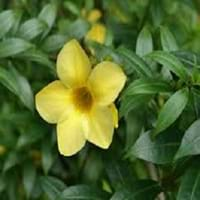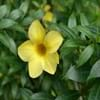Life Span
Perennial
Annual
Origin
Hybrid origin
Hybrid origin, Southern Asia
Types
Allamanda voilacea
Allamanda violacea Cherry Jubilee
Allamanda x Alba (Blanca)
Allamanda Cream
Allamanda Chocolate
Allamanda Indonesia Sunset
Allamanda hendersonii
Slicing, Pickling and burpless
Habitat
gardens, Grassland, Roadsides, Tropical regions
Floodplains, Wet forest
USDA Hardiness Zone
10-14
7-8
Sunset Zone
H1, H2, 24
A3, H1, H2, 1a, 1b, 2a, 2b, 3a, 3b, 4, 5, 6, 7, 8, 9, 10, 11, 12, 13, 14, 15, 16, 17, 18, 19, 20, 21, 22, 23, 24
Habit
Vining/Climbing
Vining/Climbing
Flower Color
Salmon, Burgundy, Dark Salmon
Yellow, Gold
Flower Color Modifier
Not Available
Bicolor
Fruit Color
Light Green, Pink
Green
Leaf Color in Spring
Light Green
Light Green
Leaf Color in Summer
Light Green
Green, Dark Green
Leaf Color in Fall
Light Green
Green, Dark Green, Yellow green
Leaf Color in Winter
Light Green
Not Available
Leaf Shape
Bell Shaped
Heart-shaped
Plant Season
Spring, Fall, Winter
Summer, Fall
Sunlight
Full Sun, Partial Sun
Full Sun, Partial Sun
Growth Rate
Very Fast
Very Fast
The pH of Soil
Acidic, Neutral, Alkaline
Neutral
Soil Drainage
Well drained
Well drained
Bloom Time
Indeterminate
Early Summer, Summer, Late Summer, Early Fall, Indeterminate
Tolerances
Drought, Salt
Drought
Where to Plant?
Ground
Container, Ground
How to Plant?
Seedlings
Seedlings, Stem Planting
Plant Maintenance
Medium
Medium
Watering Requirements
Form a Soil ring to water efficiently, Keep the ground moist but not water-logged, Requires a lot of watering, Water when soil is dry
Keep ground moist, Requires a lot of watering, Requires regular watering, Requires watering in the growing season
In Summer
Lots of watering
Lots of watering
In Spring
Moderate
Moderate
In Winter
Average Water
Average Water
Soil pH
Acidic, Neutral, Alkaline
Neutral
Soil Drainage Capacity
Well drained
Well drained
Sun Exposure
Full Sun, Partial Sun
Full Sun, Partial Sun
Pruning
Cut or pinch the stems, Prune for shortening long shoots, Prune if you want to improve plant shape, Prune in spring, Remove damaged leaves
Remove damaged leaves, Remove dead leaves, Remove shoots
Fertilizers
All-Purpose Liquid Fertilizer
All-Purpose Liquid Fertilizer, Compost, organic fertlizers
Pests and Diseases
Red blotch
Anthracnose, Bacteria wilt, Downy mildew, Fungal Diseases, fungus, Fusarium wilt, Leaf spot
Plant Tolerance
Drought
Cold climate
Flower Petal Number
Single
Single
Foliage Texture
Medium
Coarse
Foliage Sheen
Matte
Matte
Attracts
Hummingbirds
Ants, Birds, Flying insects, Insects, Rats, Squirrels
Allergy
Eye irritation, Skin irritation, Skin rash
Throat itching
Aesthetic Uses
Showy Purposes
Showy Purposes
Beauty Benefits
Not Available
Not Available
Environmental Uses
Air purification
Air purification, Food for animals, Food for birds, Food for insects
Medicinal Uses
Jaundice, Liver problems, Malaria
anti-cancer, Anti-oxidant, Antioxidants, Combats Stress, Improve heart health, Indigestion, Inflammation
Part of Plant Used
Flowers
Fruits, Seeds
Other Uses
Used as Ornamental plant
Used As Food, Used as Ornamental plant, Used for its medicinal properties
Used As Indoor Plant
No
Yes
Used As Outdoor Plant
Yes
Yes
Garden Design
Container, Feature Plant, Mixed Border, Topiary, Bonsai, Espalier, Tropical, Vine
Edible, Herb / Vegetable, Vine
Botanical Name
ALLAMANDA 'Cherries Jubilee'
CUCUMIS sativus 'Diva'
Common Name
Golden Trumpet Vine
Cucumber
In German
Allamanda
Gurke
In French
Allamanda
concombre
In Spanish
Allamanda
Pepino
In Greek
Allamanda
αγγούρι
In Portuguese
Allamanda
pepino
In Polish
Allamanda
ogórek
In Latin
Allamanda
cucumeris
Phylum
Magnoliophyta
Tracheophyta
Class
Magnoliopsida
Magnoliopsida
Order
Gentianales
Cucurbitales
Family
Apocynaceae
Cucurbitaceae
Clade
Angiosperms, Asterids, Eudicots
Angiosperms, Eudicots, Rosids
Tribe
Apocyneae
Melothrieae
Subfamily
Rauvolfioideae
Cucurbitoideae
Number of Species
Not Available
Importance of Allamanda and Cucumber
Want to have the most appropriate plant for your garden? You might want to know the importance of Allamanda and Cucumber. Basically, these two plants vary in many aspects. Compare Allamanda and Cucumber as they differ in many characteristics such as their life, care, benefits, facts, etc. Every gardener must at least have the slightest clue about the plants he wants to plant in his garden. Compare their benefits, which differ in many ways like facts and uses. The medicinal use of Allamanda is Jaundice, Liver problems and Malaria whereas of Cucumber is anti-cancer, Anti-oxidant, Antioxidants, Combats Stress, Improve heart health, Indigestion and Inflammation. Allamanda has beauty benefits as follows: Not Available while Cucumber has beauty benefits as follows: Not Available.
Compare Facts of Allamanda vs Cucumber
How to choose the best garden plant for your garden depending upon its facts? Here garden plant comparison will help you to solve this query. Compare the facts of Allamanda vs Cucumber and know which one to choose. As garden plants have benefits and other uses, allergy is also a major drawback of plants for some people. Allergic reactions of Allamanda are Eye irritation, Skin irritation and Skin rash whereas of Cucumber have Throat itching respectively. Having a fruit bearing plant in your garden can be a plus point of your garden. Allamanda has no showy fruits and Cucumber has showy fruits. Also Allamanda is not flowering and Cucumber is not flowering . You can compare Allamanda and Cucumber facts and facts of other plants too.





